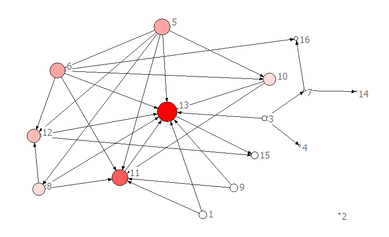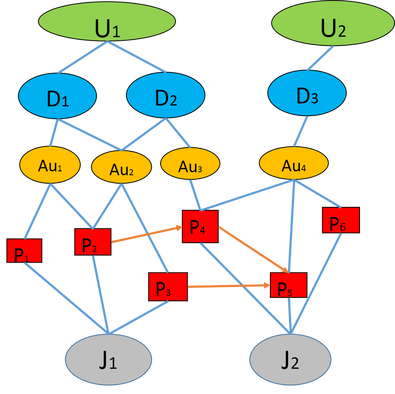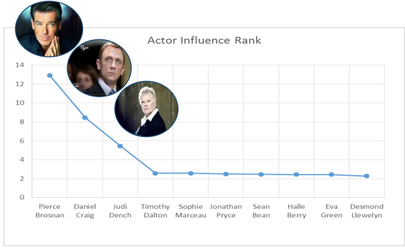Network Analysis
Paper-Researcher Academic Network Influence Measure
About ICM 2014
We formed a team to participate the contest of 2014 ICM (Interdisciplinary Contest in Modeling, held by COMAP), and we picked the topic from ICM 2014 problem set, see the downloads below.
Since the rating procedure is still going on, we have to avoid the error machine-based results in plagiarism check. Hence the detailed below is not sufficient, and we recommend you to download our solution to view more.
Since the rating procedure is still going on, we have to avoid the error machine-based results in plagiarism check. Hence the detailed below is not sufficient, and we recommend you to download our solution to view more.
Our Mission
Researcher network and paper citation networks are two well documented networks. Understanding such networks is important for researchers and institutions' decision making. There are many characteristics of the network that we are seeking for, one of which would be the influence. Who are the influential researcher and paper are the building blocks to the academic evaluating system. The current influence measurement is based on the paper citation number.
The citation number is an effective and easy-to-use indicator, but unfortunately it is still biased and far from perfect.
1) Firstly, the link between paper influence and authors influence is biased.
a) Innovative researcher may get shadowed by limited productivity originated from their large efforts on individual paper. A typical scenario would be a founding scientist who had three thousand-citing paper but only obtained an H-index of 3. The quantity of his work will offsets the profundity. Only the authors with a large number of papers with high citation will be recognized.
b) Innovative researcher will be shadowed by the limited number of journals in his field. The typical scenario is a scientist in biology and information science could easily obtain a H-index over 10, which is hard for a mathematician and theoretical physicist. Networking effect should be normalized.
c) Though paper published on prestigious journals usually gain more citations, the varied significance of publicationfrom different journals still remain not well accounted for. Especially for those innovative authors who usually publish on high rated journals gain same citation.
d) The author’s active contribution is not indicated in the H-index. Innovative author placed as the first author gain the same citation number as the second author.
e)On the connectivity side, the index say nothing about the cooperation of scholars. Such cooperation indicates the potential of innovation and the spread of academic findings
2) Secondly, the influence of paper measured by the citation number is biased.
a) Citations do not account for confounding factors such as "gratuitous authorship", the so-called Matthew effect, and the favorable citation bias associated with review articles. Again, this is a problem for all other metrics using publications or citations.
The citation number is an effective and easy-to-use indicator, but unfortunately it is still biased and far from perfect.
1) Firstly, the link between paper influence and authors influence is biased.
a) Innovative researcher may get shadowed by limited productivity originated from their large efforts on individual paper. A typical scenario would be a founding scientist who had three thousand-citing paper but only obtained an H-index of 3. The quantity of his work will offsets the profundity. Only the authors with a large number of papers with high citation will be recognized.
b) Innovative researcher will be shadowed by the limited number of journals in his field. The typical scenario is a scientist in biology and information science could easily obtain a H-index over 10, which is hard for a mathematician and theoretical physicist. Networking effect should be normalized.
c) Though paper published on prestigious journals usually gain more citations, the varied significance of publicationfrom different journals still remain not well accounted for. Especially for those innovative authors who usually publish on high rated journals gain same citation.
d) The author’s active contribution is not indicated in the H-index. Innovative author placed as the first author gain the same citation number as the second author.
e)On the connectivity side, the index say nothing about the cooperation of scholars. Such cooperation indicates the potential of innovation and the spread of academic findings
2) Secondly, the influence of paper measured by the citation number is biased.
a) Citations do not account for confounding factors such as "gratuitous authorship", the so-called Matthew effect, and the favorable citation bias associated with review articles. Again, this is a problem for all other metrics using publications or citations.
Model Overview
The team is initiated by Letian, and we have a physics major as well as two engineering major students, two of the three has economic background.
The contest guide us step-by-step and we first start from author network, then to paper network, and finally, we walk beyond the requirements, developed author-paper combined network.
Our final model of analyzing the paper-paper citation network and paper-academic entity network (entities include the author, departments, universities and journals). We utilized PageRank, HITS algorithm to calculate the network centrality, authority and connectivity. Finally, we designed a new influence measure in a cognitive aspect and for computing concern, we split the network and analyze it level by level.
The contest guide us step-by-step and we first start from author network, then to paper network, and finally, we walk beyond the requirements, developed author-paper combined network.
Our final model of analyzing the paper-paper citation network and paper-academic entity network (entities include the author, departments, universities and journals). We utilized PageRank, HITS algorithm to calculate the network centrality, authority and connectivity. Finally, we designed a new influence measure in a cognitive aspect and for computing concern, we split the network and analyze it level by level.
Gallery

The directional connection and centrality of 16 papers offered in contest.
Drawn by UCINET 6
Drawn by UCINET 6

Academic network, the combination of a directional network and a hierarchical non-directional network, similar to semi-bipartite

Application: Analyzing James Bond Films
We analyzed the success of 8 chained James Bond Movies (the first step of the split-network model) and linked the results into the actor-film network.
We analyzed the success of 8 chained James Bond Movies (the first step of the split-network model) and linked the results into the actor-film network.
The list of 16 founding papers for network analysis (offered in ICM 2014 as analyzing material)
Erdös, P. and Rényi, A., On Random Graphs, Publicationes Mathematicae, 6: 290-297, 1959.
Albert, R. and Barabási, A-L. Statistical mechanics of complex networks. Reviews of Modern Physics, 74:47-97, 2002.
Bonacich, P.F., Power and Centrality: A family of measures, Am J. Sociology. 92: 1170-1182, 1987.
Barabási, A-L, and Albert, R. Emergence of scaling in random networks. Science, 286:509-512, 1999.
Borgatti, S. Identifying sets of key players in a network. Computational and Mathematical Organization Theory, 12: 21-34, 2006.
Borgatti, S. and Everett, M. Models of core/periphery structures. Social Networks, 21:375-395, October 2000
Graham, R. On properties of a well-known graph, or, What is your Ramsey number? Annals of the New York Academy of Sciences, 328:166-172, June 1979.
Kleinberg, J. Navigation in a small world. Nature, 406: 845, 2000.
Newman, M. Scientific collaboration networks: II. Shortest paths, weighted networks, and centrality. Physical Review E, 64:016132, 2001.
Newman, M. The structure of scientific collaboration networks. Proc. Natl. Acad. Sci. USA, 98: 404-409, January 2001.
Newman, M. The structure and function of complex networks. SIAM Review, 45:167-256, 2003.
Watts, D. and Dodds, P. Networks, influence, and public opinion formation. Journal of Consumer Research, 34: 441-458, 2007.
Watts, D., Dodds, P., and Newman, M. Identity and search in social networks. Science, 296:1302-1305, May 2002.
Watts, D. and Strogatz, S. Collective dynamics of `small-world' networks. Nature, 393:440-442, 1998.
Snijders, T. Statistical models for social networks. Annual Review of Sociology, 37:131–153, 2011.
Valente, T. Social network thresholds in the diffusion of innovations, Social Networks, 18: 69-89, 1996.
Albert, R. and Barabási, A-L. Statistical mechanics of complex networks. Reviews of Modern Physics, 74:47-97, 2002.
Bonacich, P.F., Power and Centrality: A family of measures, Am J. Sociology. 92: 1170-1182, 1987.
Barabási, A-L, and Albert, R. Emergence of scaling in random networks. Science, 286:509-512, 1999.
Borgatti, S. Identifying sets of key players in a network. Computational and Mathematical Organization Theory, 12: 21-34, 2006.
Borgatti, S. and Everett, M. Models of core/periphery structures. Social Networks, 21:375-395, October 2000
Graham, R. On properties of a well-known graph, or, What is your Ramsey number? Annals of the New York Academy of Sciences, 328:166-172, June 1979.
Kleinberg, J. Navigation in a small world. Nature, 406: 845, 2000.
Newman, M. Scientific collaboration networks: II. Shortest paths, weighted networks, and centrality. Physical Review E, 64:016132, 2001.
Newman, M. The structure of scientific collaboration networks. Proc. Natl. Acad. Sci. USA, 98: 404-409, January 2001.
Newman, M. The structure and function of complex networks. SIAM Review, 45:167-256, 2003.
Watts, D. and Dodds, P. Networks, influence, and public opinion formation. Journal of Consumer Research, 34: 441-458, 2007.
Watts, D., Dodds, P., and Newman, M. Identity and search in social networks. Science, 296:1302-1305, May 2002.
Watts, D. and Strogatz, S. Collective dynamics of `small-world' networks. Nature, 393:440-442, 1998.
Snijders, T. Statistical models for social networks. Annual Review of Sociology, 37:131–153, 2011.
Valente, T. Social network thresholds in the diffusion of innovations, Social Networks, 18: 69-89, 1996.
Downloads
| icm_2014_problem.pdf | |
| File Size: | 582 kb |
| File Type: | |
| Our Solution_Summary_Sheet.pdf | |
| File Size: | 111 kb |
| File Type: | |
| Our Solution_Complete_noctrlno.pdf | |
| File Size: | 1332 kb |
| File Type: | |
